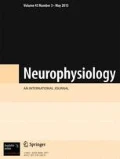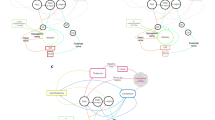We studied changes in the levels of Fos immunoreactivity and NADPH diaphorase reactivity in the autonomic nuclei and catecholaminergic (CA) groups of brainstem cells in rats that realized food-procuring movements by the forelimb. Fos-immunoreactivity in the medullary nuclei of the autonomic nervous system, ANS (Sol, IRt, CVL/RVL), of these animals was appreciably higher than that in control rats. Under such conditions, a considerable part of motoneurons in the brainstem autonomic motor nuclei (10, Amb, and RAmb) were activated. In the motor nuclei of the vagus nerve, large Fos-immunoreactive (Fos-ir) neurons were observed. In rats, therefore, intense autonomic reactions closely related to realization of a motor program develop during sessions of operant food-procuring movements. The expression of protein c-Fos in brainstem CA neurons during the performance of operant movements was intensified, mostly on the contralateral side. In the brainstem CA groups А5 and А6 (LC/SC), we observed a maximum number of Fos-ir neurons, as compared with the control values. These cell groups are formed mostly of noradrenergic neurons that are the main sources of descending inhibitory inputs to the spinal thorasic and lumbar intermediolateral sympathetic nuclei. Therefore, the ANS can directly influence the functioning of muscle spindles and proprioceptors and can, as a result, influence the realization of motor program.
Similar content being viewed by others
References
A. Ruffini, “On the minute anatomy of the neuromuscular spindles of the cat, and their physiological significance,” J. Physiol., 23, 190-208 (1898).
S. Roatta, U. Windhorst, M. Ljubisavjevic, et al., “Sympathetic modulation of the muscle spindle afferent sensitivity to stretch in rabbit jaw closing muscles,” J. Physiol., 540, 237-248 (2002).
F. Hellström, S. Roatta, J. Thunberg, et al., “Responses of muscle spindles in feline dorsal neck muscles to electrical stimulation of the cervical sympathetic nerve,” Exp. Brain Res., 165, 328-342 (2005).
D. Radovanovic, K. Peikert, M. Lindström, et al., “Sympathetic innervation of human muscle spindles,” J. Anat., 226, 542-548 (2015).
D. R. Seals and R. G. Victor, “Regulation of muscle sympathetic nerve activity during exercise in humans,” Exerc. Sport Sci. Rev., 19, 313-349 (1991).
R. Matsuo, A. Ikehaza, T. Nokubi, et al., “Inhibitory effect of sympathetic stimulation on activities of masseter muscle spindles and the jaw jerk reflex in rat,” J. Physiol., 483, 239-250 (1995).
A. Zagon and A. D. Sanith, “Monosynaptic projections from the rostral ventrolateral medulla oblongata to identified sympathetic preganglionic neurons,” Neuroscience, 265, 149-155 (1993).
A. D. Loewy, S. McKellar, and C. B. Saper, “Direct projections from the A5 catecholamine cell group to the intermediolateral cell column,” Brain Res., 174, 309-314 (1979).
H. G. J. M. Kuypers and V. A. Maisky, “Retrograde axonal transport of horseradish peroxidase from spinal cord to brain stem groups in the cat,” Neurosci. Lett., 1, 9-14 (1975).
N. Z. Doroshenko and V. A. Maiskii, “Bulbar and pontine sources of catecholamine innervation of the rat spinal cord investigated by monoamine fluorescence and retrograde labeling techniques,” Neurophysiology, 18, No. 4, 367-374 (1986).
T. L. Krukoff, “Central action of nitric oxide in regulation of autonomic function,” Brain Res.–Brain Res. Rev., 30, 52-65 (1999).
M. Sheng and M. E. Greenberg, “The regulation and function of c-fos and other immediate early genes in the nervous system,” Neuron, 4, 477-485 (1990).
A. V. Dovgan’, O. V. Vlasenko, A. V. Maznychenko, et al., “Operant reflexes and expression of the c-fos gene in the amygdalar nuclei and insular cortex of rats,” Neurophysiology, 43, No. 3, 244-247 (2011).
O. V. Vlasenko, T. V. Buzyka, V. A. Maiskii, et al., “Activation of neurons of the medullary centers of the autonomic nervous system related to motivated operant movements realized by rats,” Neurophysiology, 42, No. 5, 325-337 (2010).
O. V. Dovgan’, O. V. Vlasenko, I. L. Rokunets, et al., “Food-procuring stereotype movements is accompanied by changes of c-fos gene expression in the amygdala and modulation of heart rate in rats,” Int. J. Physiol. Pathophysiol., 4, No. 2, 1-15 (2013).
O. V. Vlasenko, Ye. P. Man’kovskaya, A. V. Maznichenko, et al., “Fos immunoreactivity in the motor cortex of rats realizing operant movements: changes after systemic introduction of a NOS blocker,” Neurophysiology, 45, No. 1, 79-83 (2013).
S.-M. Hsu, L. Raine, and H. Fanger, “Use of avidinbiotin-peroxidase complex (ABC) in immunoperoxidase techniques: a comparison between ABC and unlabelled antibody (PAP) procedures,” J. Histochem. Cytochem., 29, 577-580 (1981).
G. Paxinos and C. Watson, The Rat Brain in Stereotaxic Coordinates, Academic Press, New York (1998).
S. R. Vincent and H. Kimura, “Histochemical mapping of nitric oxide synthase in the rat brain,” Neuroscience, 46, 755-784 (1992).
M. Kalia, K. Fuxe, and M. Goldstein, “Rat medulla oblongata. II. Noradrenergic neurons, nerve fibres and preterminal processes,” J. Comp. Neurol., 233, 308-332 (1985).
M. Kalia, K. Fuxe, and M. Goldstein, “Rat medulla oblongata. III. Adrenergic (C1 and C2) neurons, nerve fibres and presumptive terminal processes,” J. Comp. Neurol., 233, 333-349 (1985).
O. V. Vlasenko, A. I. Pilyavskii, V. A. Maiskii, and A. V. Maznichenko, “Fos-immunoreactrivity and NADPH-d reactivity in the brain cortex of rats realizing motivated stereotyped movements by the forelimb,” Neurophysiology, 40, No. 4, 295-303 (2008).
D. L. Adkins, J. Boychuk, M. S. Remple, et al., “Motor training induces experience-specific patterns of plasticity across motor cortex and spinal cord,” J. Appl. Physiol., 101, 1776-1782 (2006).
Ye. P. Man’kovskaya, V. A. Maisky, O. V. Vlasenko, et al., “7-Nitroindazole enhances c-Fos expression in spinal neurons in rats realizing operant movements,” Acta Histochem., 116, 1427-1433 (2014).
A. V. Dovgan’, O. V. Vlasenko, V. A. Maiskii, et al. “Topography of Fos-immunoreactivity and NADPH-dreactive neurons in the limbic structures of the basal forebrain and in the hypothalamus during realization of motivated operant movements in rats,” Neurophysiology, 41, No. 1, 28-36 (2009).
M. T. Koh, E. E. Wilkins, and I. L. Bernstein, “Novel tastes elevate c-fos expression in the central amygdala and insular cortex: implication for taste aversion learning,” Behav. Neurosci., 117, 1416-1422 (2003).
A. J. Nelson, J. M. Juraska, T. I. Musch, and G. A. Iwamoto, “Neuroplastic adaptations to exercise: neuronal remodeling in cardiorespiratory and locomotor areas,” J. Appl. Physiol., 99, 2312-2322 (2005).
P. J. Mueller, “Exercise training attenuates increases in lumbar sympathetic nerve activity produced by stimulation of the rostral ventrolateral medulla,” J. Appl. Physiol., 102, 803-813 (2007).
V. A. Maisky and N. Z. Doroshenko, “Catecholamine projections to the spinal cord in the rat and their relationship to central cardiovascular neurons,” J. Auton. Nerv. Syst., 34, 119-128 (1991).
R. Y. Moore and F. E. Bloom, “Central catecholamine neuron systems: anatomy and physiology of the norepinephrine and epinephrine systems,” Annu. Rev. Neurosci., 2, 113-168 (1979).
P. F. McCulloch and W. M. Panneton, “Activation of brainstem catecholaminergic neurons during voluntary diving in rats,” Brain Res., 984, 42-53 (2003).
M. Passatore and S. Roatta, “Influence of sympathetic nervous system on sensomotor function: whiplash associated disorders (WAD) as a model,” Eur. J. Appl. Physiol., 98, 423-449 (2006).
Author information
Authors and Affiliations
Corresponding author
Rights and permissions
About this article
Cite this article
Mankivska, O.P., Vlasenko, O.V., Mayevskii, O.E. et al. Cerebral Structures Responsible for the Formation of Autonomic Reflexes Related to Realization of Motivated Operant Movements by Rats. Neurophysiology 49, 396–404 (2017). https://doi.org/10.1007/s11062-018-9702-x
Received:
Published:
Issue Date:
DOI: https://doi.org/10.1007/s11062-018-9702-x




